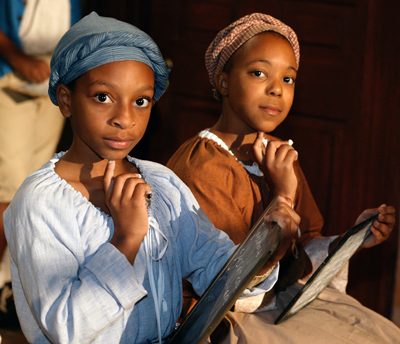Page 71-73 A Black History of Fredericksburg, Stafford and Spotsylvania, A Different Story – Ruth Coder Fitzgerald

Education and Religion
“Religion and education both were important concerns in southern black communities, long before the Civil War, although restrictions were placed on religious services, and learning to read and write was, for most of the era, against the law.
“One reason advanced for enforcing illiteracy was to prevent pass forgery by runaways. Occasionally, however, a school or class for blacks.
“On such school operated in Fredericksburg from 1765 to 1770 with tie financial help of an English group called the Associates of Dr. Thomas Bray. Bray, an English missionary, represented another British group, the Society for the Propagation of the Gospel in Foreign Parts, which still exists.
“These groups saw the religious conversion of Indians and blacks to be an important part of their overseas mission, and with the aid of Dr. Bray, schools were set up in such places as Williamsburg and Philadelphia, in addition to Fredericksburg.
“Aside from such schools, few slaves or free blacks received any formal education. And, with the beginning of the American Revolution, British enthusiasm and funds ended?
“The slave school in Fredericksburg was begun because of interest of the Reverend James Marye, an Anglican priest, and Fielding Lewis, another prominent Fredericksburg citizen.
“A letter from colonial Virginia concerning the school was read before the Bray Associates’ meeting in London on April 4, 1765. Written the previous September, the letter was from the Reverend Marye’s son, also named James, a minister in Orange County, Virginia.
“The younger Marye reported that he had been in Fredericksburg recently on a visit to his father, minister of the local parish, “…and made inquiry what number of young Negroes might be sent should a school be opened there, and could not learn it would be possible to get above four or five, or thereabout, and they not to go constantly, but only at spare times as it suites their owners. The number of adult Negroes in his parish he thinks may be about one thousand and the same number of young ones. The number attending divine worship on Sundays differs at different churches, but in general there are about 30 or 40 on some Sundays he as seen 60 or more. The number of Negroe communicants is very small not exceeding half a dozen or thereabout. All that understand English and are tolerably convenient for the church bring their children to be baptized.”
“It is not recorded what language was spoken by those who did not understand English.
“The administrative work of the school was to be done by Fielding Lewis, brother-in-law of George Washington, and by the elder Reverend Marye, whose work was taken over at his death in 1767 by his son, James. By September of 1765, books had been sent from England for the school. The two Maryes encouraged the use of the school in sermons and conversations and helped to find students, while Lewis arranged for the school’s operation.
“The Bray Associates paid for the salary of the teacher, whose name is unknown, and for the books and the rent of the building. Work had begun in April, 1765, and Lewis reported in a September 14 letter that year about difficulties finding a “…proper person to undertake the School for the Education of Negroe Children, the allowance being so small, that the greatest part of it will be paid for the house rent hiring.”
“Despite his difficulties there were 16 students enrolled and Lewis said that because the children has begun “…allready to read prettily there will be occasion for a few Testaments and Prayer Books, for I propose introducing them into Church as soon as they are capable of joyning in the service.”
“In a letter recorded in the minutes of the Bray Associates for April 2, 1767, Lewis complained that the slave owners in the area were not willing to let students attend for the five years deemed necessary for a “proper degree of instruction,” and asked for the general advice of the Associates.
“They requested that he keep the school open “in hopes that much good may result from it” for the young students, who ranged in age from five to eight years.
“But discouragement over low enrollment was apparent by 1768. In a letter of October 31 of that year, Lewis said that only nine young blacks attended constantly and only four in the summer season, •ben slaves were needed for planting and harvesting. He wondered if he should continue the school, since the students left as soon as they could read, to work for their owners.
“His letter of February 1, 1772, reported to the Associates that the school finally had been closed in 1770. He wrote: “It gives me the greatest concern that so much money should have been expended to so little purpose and am of opinion that a school will never succeed in a small town with us, as the number of Negroes are few and many believe that the learning them to read is rather a disadvantage to the owner.
“However, the education of blacks did continue, to some extent, in early Sunday schools in Virginia. Young blacks were also sometimes taught by their owners’ families to read and write, generally so they would be able to read the Bible.”
